
The SIGIL alphabet was invented for SIGIL, an a priori language being developed by Ian James since 2006. The acronym stands for Scenic Intuitive Glomerate Ideal Language, and the system for writing it presented here is the 24th version from October 2009, stable enough to be used for transliteration of other languages (such as English) until final release of SIGIL itself in the near future.
The shapes of the consonants derive from perceived features of phonemic production. But there are six primary base shapes, relating to locations in the mouth, to which modifier strokes and tails are added. Here is the complete P series, produced at the lips; the base shape is soft, bulging and puffy.
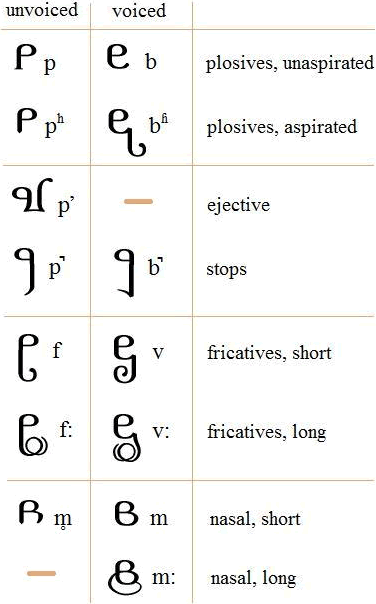
SIGIL does not use the unvoiced unaspirated plosive (found in Thai etc) or the voiced aspirated plosive (found in Hindi etc), but they are available for transliteration. Here are the six primary base shapes, shown in their unvoiced aspirated plosive form:
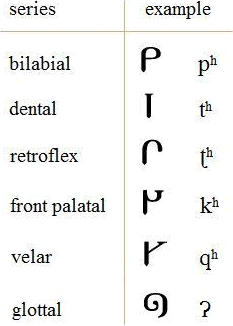
The T base represents a small tapper; the R base (retroflex) represents a soft springy beater; the K base represents a sharp cut high on the palate; the Q base is similar, but deeper; the H base represents a deep swirl (the words "spirant" and "spiral" are related). Some other important phonemes fall outside these sets. The S, SS and L series do not have plosives, for example. The S (alveolar) and SS (alveolopalatal) bases are derived from the T base, the L base comes from the vowel shape (see below). In addition, the H series runs a little different to the others; the phoneme marked as ejective is actually just a stop+plosive combination. There is also a glyph for the alveolar or retroflex tap, derived from the retroflex base.
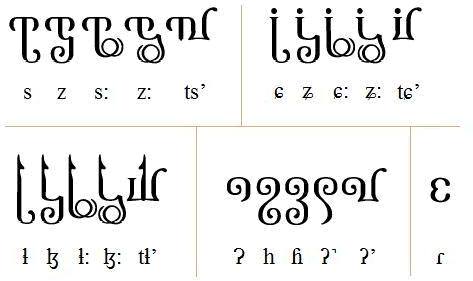
As can be seen in the transliteration of "sigil" above, affricates are written as a stop followed by a fricative.
The base shape for all vowels (and semivowels) is a resonating bowl. The most open phoneme has no additional marking, but the others have a modifier above. Rounded vowels add a rounding closure to the bowl. If two or more vowels are produced in sequence, the bowls are joined to form one base glyph, upon which the modifiers float.
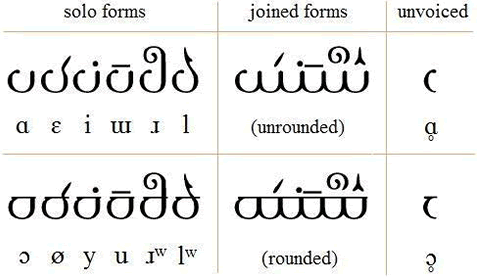
The E modifier represents a free outward effect; the I modifier represents a small tight effect; the U modifier represents a channel; the R modifier represents a soft rolling effect, and the L modifier represents a raised forking effect. For unvoiced (whispered) vowels, the bowl is only half formed.
Initial vowels are usually preceded by a glottal plosive, unless a gradual onset is desired. Gradual onset is the case especially for initial /j/ and /w/, which are otherwise considered to be the same as /i/ and /u/.
Tones are used in SIGIL mainly for syntactic purposes. Each affected vowel is marked with either a high tone (a line representing a raised level of liquid in the bowl and consequent higher pitch), or a low tone (a vertical line below). In combination, falling and rising tones may be formed. Here is an example of transliterating a passage of Thai which shows use of tones, as well as unvoiced unaspirated plosives:

In addition, this passage shows tightening of two vowels into a quick diphthong /ai/, by use of a small v-bracket below the pair.
The numerals (except for the figure zero) are simply formed by joining the relevant numbers of imaginary dots with the least number of strokes. There are glyphs up to 15, to allow consistent counts in hexadecimal; the extra shapes also bear some resemblance to the standard ABCDEF letter forms.
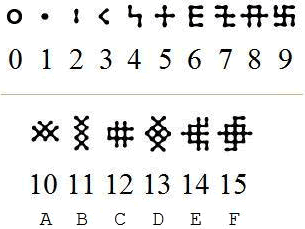
Punctuation and other markings are fairly straightforward. In and out breaths are written explicitly and translate roughly into standard comma etc. The proper noun prefix is derived from the Egyptian ankh symbol of life. The transliteration brackets represent lips with teeth, and the mere sound which emerges from between them.
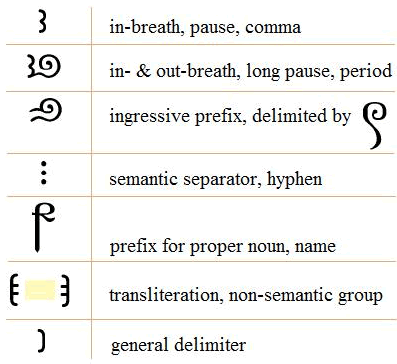
This is really just a transliteration, but it shows how the SIGIL script runs:

All human beings are born free and equal in dignity and rights. They are endowed with
reason and conscience and should act towards one another in a spirit of brotherhood.
(Article 1 of the Universal Declaration of Human Rights)
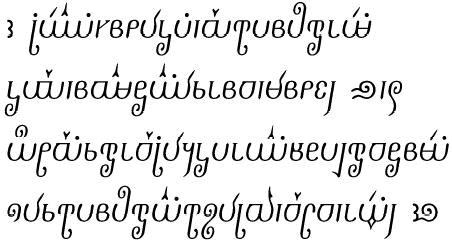
These are famous lines from Shakespeare. Can anyone identify them?
Feedback about SIGIL may be sent to [ianrjames at hotmail dotcom]
Akkhara Muni, Amethyst, Bostani, Elektrum, Fontok, Klaekson-Zaen, Maui, New Akha, New Maori, New Mong, Pranish, SIGIL, Sigil Panel Script, Slinseng-Fi, Tengwar for Scottish Gaelic, Xylphika
See also: http://www.skyknowledge.com/orthographies.htm
Constructed scripts for: Ainu | Arabic | Chinese languages | Dutch | English | Hawaiian | Hungarian | Japanese | Korean | Lingala | Malay & Indonesian | Persian | Tagalog / Filipino | Russian | Sanskrit | Spanish | Taino | Turkish | Vietnamese | Welsh | Other natural languages | Colour-based scripts | Tactile scripts | Phonetic/universal scripts | Constructed scripts for constructed languages | Adaptations of existing alphabets | Fictional alphabets | Magical alphabets | A-Z index | How to submit a constructed script
[top]
You can support this site by Buying Me A Coffee, and if you like what you see on this page, you can use the buttons below to share it with people you know.

If you like this site and find it useful, you can support it by making a donation via PayPal or Patreon, or by contributing in other ways. Omniglot is how I make my living.
Note: all links on this site to Amazon.com, Amazon.co.uk
and Amazon.fr
are affiliate links. This means I earn a commission if you click on any of them and buy something. So by clicking on these links you can help to support this site.
[top]